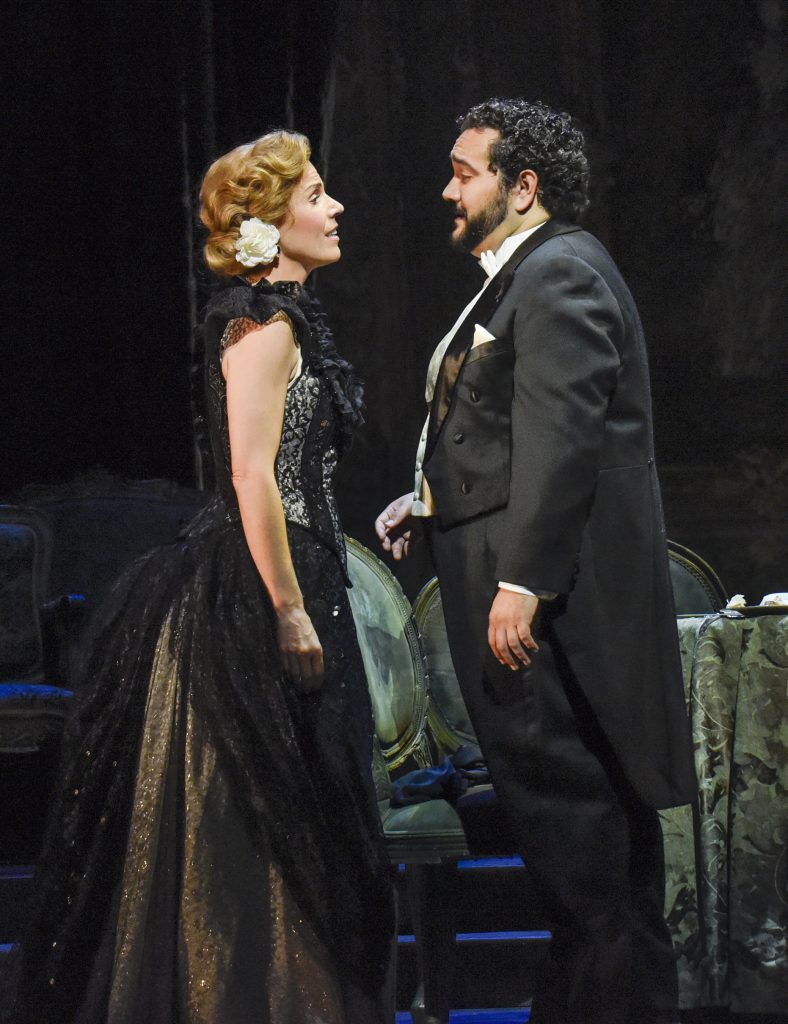Dallas Opera offers a freshly conceived, vocally gleaming take on “Traviata”

Georgia Jarman and Rene Barbera star in Verdi’s “La Traviata” at Dallas Opera. Photo: Karen Almond
Dallas Opera scored a second major success of the season with a beautifully sung, opulently staged production of Verdi’s La Traviata Friday night at Winspear Opera House, with a penetrating musical performance made all the more fascinating by subtle and not-so-subtle visual amendments to the drama.
Vocally, Friday night’s performance was as nearly perfect a Traviata as one could hope for. As Violetta, Georgia Jarman possesses a noticeably intense vibrato. The soprano began with a fairly bright tone that warmed into a darker, richer timbre as the evening progressed; intentional or not, this gave a sense of deepening maturity on the part of the character that matched her progression from depressed debauchee to temporarily happy woman to dying victim.
And Jarman explored the character vocally far beyond the traditional portrayal of Violetta as a tubercular young woman. In “Sempre libera,” her closing aria in Act I, Violetta is clearly indicated as alcoholic and near break down, turning this bel canto movement into mad scene, with vocal acrobatics expressing not so much determination to enjoy what remains of her life but a desperate, almost enraged defiance in the face of inevitable fate. At this point, Jarman clearly displayed that the rich expansiveness of her tone reaches into an impressive flexibility and lightness—not to mention a clear, strong high D in the middle of one of the most challenging patches in this aria.
Texas native René Barbera made his Dallas Opera debut as Alfredo with a consistently substantial and attractive tone that carried beautifully into upper registers and louder volume—for instance, delicately brushing the high C when he interrupts from offstage in Violetta’s “Sempre libera,” then landing with beauty and forcefulness on a high A-flat in his op project nicely in a fairly large but acoustically friendly theater such as this one; he definitely has a ready-made career niche in roles of this ilk, and, at this point, appears headed toward stardom.
The Belorussian-born, Russian-trained baritone Vladislav Sulimsky sang the role of Giorgio Germont with sturdy richness and appropriate darkness of tone.
Conductor Carlo Montanaro, making his Dallas debut, brought a sure hand to the nuances and dramatic impetus of the score. Stunning moments abounded, but the second act party scene, one of the most dramatic moments in all opera, unfolded, as it should, with breath-taking impact, thanks to a steady command of the tricky tempo and mood changes in this scene.
Adding to the fascination of the scene, choreographer John de los Santos effectively staged the ballet for a single sensually-charged couple in black and white, surrounded by the colorful swirl of party-goers
Desmond Heeley’s sets and costumes, originally designed for Lyric Opera of Chicago, provided an extravagant backdrop for this tale of the fall of a nineteenth-century Parisian courtesan. Within this intricate and ornamental setting, however, Italian stage director Stefania Panighini, making her American debut, brought numerous unusual touches—some obvious, some not. A shadow version of Violetta, clad in white, actually appears on stage during the Overture before the first appearance of the real Violetta; what to make of this double’s final transformation three hours later in the final moments, when she dons one of Violetta’s glamorous black gowns, is left to the audience to decide.
While, under director Panighini, Jarman’s version of Violetta pushes the boundary of how far one can take the ill-fated courtesan, Alfredo in this production remains, in keeping with tradition, a young man manipulated by his passion and suppressed by an overbearing father, approaching hysteria only when Giorgio Germont confronts him at the end of Act II.
And Sulimsky’s dramatic rendition of the elder Giorgio Germont is anything but traditional. Although he maintains the solid, somber demeanor one expects from this character, strange, unexpected—and, in terms of the score and libretto, wholly unauthorized)—things start to happen not long after he arrives at Violetta’s country house. He toys with her mercilessly, touching her breast, physically looming over her, helping himself to a drink, and offering her jewelry and stacks of cash in the manner of a odious twenty-first century CEO attempting to seduce a subordinate.
While this might seem contradictory to his role (since, later in Act II, he arrives as the defender of Violetta’s honor at the masquerade party), one might consider this as representative of his underlying hypocrisy: he is, after all, more concerned that his daughter make a good marriage than that a woman of a lower social class survives.
Ultimately, the three different dramatic approaches for the principal roles meld convincingly into a realistic interplay of different personality types. Indeed, director Panighini’s vision of Traviata, as played out by the three principal characters, quite successfully expands Verdi’s drama of one person’s tragedy into an attack on classism and economic exploitation.
Viewing Traviata for its political or sociological undercurrents is, of course, purely optional and somewhat speculative; more importantly, regardless of the intriguing, non-verbal directorial insertions, Dallas Opera here presents a musically solid, visually engaging rendition worthy of one of the greatest and deservedly most beloved of operas.
Dallas Opera’s production of La Traviata runs through November 12 at Winspear Opera House. dallasopera.org; 214-443-1043